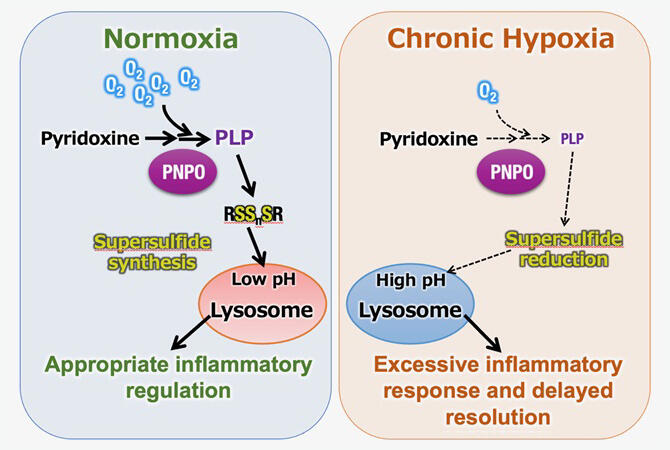A research group led by Associate Professor Hiroki Sekine and Professor Hozumi Motohashi of Tohoku University Graduate School of Medicine, in collaboration with the University of Tokyo, Kyushu University and other institutions, has announced the discovery of the "PNPO−PLP axis" as an oxygen-sensing system responsive to prolonged hypoxia. Prolonged hypoxia exacerbates inflammation in mouse macrophages. The group found that the enzyme PNPO mediates the conversion of vitamin B6 to active vitamin B6 (PLP: pyridoxal phosphate) in an oxygen level-dependent manner and regulates inflammatory cell functions. Because prolonged hypoxia is associated with aging, cancer, respiratory diseases and other conditions, the findings are expected to contribute to the development of prophylactic and therapeutic means for these conditions. The results were published in the May 31 issue of the international journal Nature Metabolism.

Provided by Tohoku University
The response to hypoxia induced acutely by ischemia and other conditions involves the PHD−HIF axis, and the discovery of HIF (hypoxia-inducible factor) was the achievement for which the 2019 Nobel Prize in Physiology or Medicine was awarded. However, it remained unknown whether this axis is involved in prolonged hypoxia.
In this study, the research group examined whether the inflammatory responses differ between short-term hypoxia (acute hypoxia) and prolonged hypoxia (chronic hypoxia) in mouse macrophages. Mouse bone marrow progenitor cells were induced to differentiate into macrophages under conditions of normoxia, acute hypoxia and chronic hypoxia, and activated macrophages obtained through inflammatory activation were subjected to comprehensive genetic analysis.
The results showed that the inflammatory response in chronic hypoxia was elevated compared with that in normoxia or acute hypoxia. Elevated proinflammatory cytokines and decreased anti-inflammatory cytokines were observed. To examine whether the activation of the inflammatory response in chronic hypoxia is PHD−HIF-regulated, the same experiments were performed using knockout mice in which HIF1a involved in the PHD−HIF pathway was suppressed. The results showed that activation of the inflammatory response was not suppressed, indicating the involvement of a different pathway in this activation. Furthermore, the decreased expression and activity of lysosome-related genes were observed in chronic hypoxia.
Lysosomes are involved in intracellular waste degradation. To clarify how chronic hypoxia causes a decrease in lysosomal activity, they examined metabolites altered by chronic hypoxia in macrophages. The active vitamin B6 (PLP and pyridoxal) levels were dramatically reduced compared with those in the normoxia condition. Active vitamin B6 is synthesized by the enzyme PNPO, which uses oxygen as a substrate, and hypoxia could be attributed to this drastic decrease. Therefore, they performed an experiment in which oxygen was supplied after intracellular PLP decreased because of chronic hypoxia and found that PLP was synthesized rapidly after oxygen supply. They confirmed that suppression of the PNPO gene was accompanied by reduced PLP synthesis. PLP is known to be essential as a coenzyme for many enzymes.
One such molecule was supersulfide, which was identified to be a factor involved in resolution of inflammatory responses by Motohashi and her colleagues last year. Therefore, they examined the effects of chronic hypoxia on supersulfide production and found that the supersulfide level decreased. They also confirmed that reduced lysosomal function and enhanced inflammatory responses due to chronic hypoxia were restrained by the addition of active vitamin B6 and supersulfide. In chronic hypoxia, the amounts of oxygen-dependently synthesized active vitamin B6 and supersulfide were reduced and excessive inflammatory response persisted. This study is the first to show that vitamin B6 is an oxygen-sensitive vitamin. Vitamin B6 marketed as a dietary supplement in Japan is the inactive form, and it is not expected to be effective by simple ingestion.
According to the research group, a study to examine the correlation with vitamin B6 in the blood and other samples from patients with diseases associated with chronic hypoxia is being considered. Sekine said, "Chronic hypoxia can be caused by, for example, age-related decline in cardiopulmonary function, and we believe that chronic hypoxia may have a risk of increasing the severity of inflammation. So, we are hopeful that diseases associated with chronic hypoxia can be alleviated by supplementation with active vitamin B6, supersulfide and similar compounds."
Journal Information
Publication: Nature Metabolism
Title: PNPO-PLP axis senses prolonged hypoxia in macrophages by regulating lysosomal activity
DOI: 10.1038/s42255-024-01053-4
This article has been translated by JST with permission from The Science News Ltd. (https://sci-news.co.jp/). Unauthorized reproduction of the article and photographs is prohibited.




